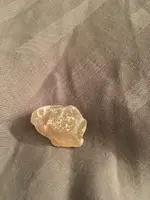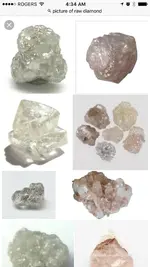You are using an out of date browser. It may not display this or other websites correctly.
You should upgrade or use an alternative browser.
You should upgrade or use an alternative browser.
Diamond
- Thread starter Jakel
- Start date
DDancer
Bronze Member
- Joined
- Mar 25, 2014
- Messages
- 2,339
- Reaction score
- 2,003
- Golden Thread
- 0
- Location
- Traveling US to work
- Detector(s) used
- Current Equinox 600
Past Whites DFX Garret GTI 2500 and others
Prospecting Minelab GPZ 7000
Past SD 2100 GP 3000 (retired)
- Primary Interest:
- All Treasure Hunting
Not diamond, not agate. Appears to be a bit of chalcedony a quartz mineral. Hardness test would help. Why do you think its diamond?
Upvote
0
MartyRocks
Jr. Member
- Joined
- Dec 12, 2015
- Messages
- 45
- Reaction score
- 18
- Golden Thread
- 0
- Location
- Nevada desert
- Detector(s) used
- None yet.
- Primary Interest:
- All Treasure Hunting
Damn! If that is a diamond.... I've got a bucketful in the shed!
We find a lot of them in the desert here.
Sorry to say, DDancer is correct... not a diamond, looks more like chalcedony.
Notice your piece is rather dull, not as sparkly. Best way to find out... test it!
We find a lot of them in the desert here.
Sorry to say, DDancer is correct... not a diamond, looks more like chalcedony.
Notice your piece is rather dull, not as sparkly. Best way to find out... test it!
Upvote
0
From Wikipedia:
"Agate /ˈæɡət/ is a cryptocrystalline variety of silica, chiefly chalcedony, characterised by its fineness of grain and brightness of color. Although agatesmay be found in various kinds of rock, they are classically associated with volcanic rocks and can be common in certain metamorphic rocks."
Call it agate. Call it chalcedony. It does not matter. It is still not diamond.
"Agate /ˈæɡət/ is a cryptocrystalline variety of silica, chiefly chalcedony, characterised by its fineness of grain and brightness of color. Although agatesmay be found in various kinds of rock, they are classically associated with volcanic rocks and can be common in certain metamorphic rocks."
Call it agate. Call it chalcedony. It does not matter. It is still not diamond.
Upvote
0
DDancer
Bronze Member
- Joined
- Mar 25, 2014
- Messages
- 2,339
- Reaction score
- 2,003
- Golden Thread
- 0
- Location
- Traveling US to work
- Detector(s) used
- Current Equinox 600
Past Whites DFX Garret GTI 2500 and others
Prospecting Minelab GPZ 7000
Past SD 2100 GP 3000 (retired)
- Primary Interest:
- All Treasure Hunting
Ah. Well as you can see in your photo's, and it holds true for all the raw diamond I have ever seen, your bit lacks the luster and formation of a raw diamond. However when in doubt a simple hardness test will tell you for sure. A carbide drill bit wont scratch a diamond. Hardness tests are one of the first, and easiest, tests to figure out what one has in hand.
As to agate I dont see any evidence of banding which is one of the qualifiers for that version of the mineral chalcedony. Coloration is important as well.
As to agate I dont see any evidence of banding which is one of the qualifiers for that version of the mineral chalcedony. Coloration is important as well.
Upvote
0
The_Piratess
Bronze Member
- Joined
- Apr 4, 2017
- Messages
- 1,086
- Reaction score
- 1,728
- Golden Thread
- 0
- Location
- Ghost Ship
- Detector(s) used
- Whites Beach Hunter ID, so far...
- Primary Interest:
- All Treasure Hunting
Most definitively not a diamond, sorry. Diamonds in the rough have a very oily texture to them and they wash off very easily due to their oily surface. They are also very cold to the touch which is why they are often referred to as ice. Many look like sea glass especially the kind that are octahedron, macle or have other geometrical shapes to them. However most do not appear sparkly until they are cut and faceted with the exception of brown diamonds which have a metallic looking shine to them.
Simple ways to test them yourself are with an inexpensive diamond tester (just make sure that it is properly calibrated first), looking at it through a high magnification, jewelers loupe preferably with a light and you will see triangular macle formations throughout or simply by scratching on a piece of glass with it to see if it cuts it. Hope this helps.
Simple ways to test them yourself are with an inexpensive diamond tester (just make sure that it is properly calibrated first), looking at it through a high magnification, jewelers loupe preferably with a light and you will see triangular macle formations throughout or simply by scratching on a piece of glass with it to see if it cuts it. Hope this helps.
Last edited:
Upvote
0
Eu_citzen
Gold Member
Be wary of the glass-myth. In fact a whole lot of minerals, even common ones, will scratch glass.
Using something harder then glass, like sapphire is better. Couple it with a specific gravity test and you'll hopefully have a good idea of what you're dealing with.
Not all rough diamonds show the macle thing, I think.
Using something harder then glass, like sapphire is better. Couple it with a specific gravity test and you'll hopefully have a good idea of what you're dealing with.
Not all rough diamonds show the macle thing, I think.
Upvote
0
- Joined
- Aug 19, 2014
- Messages
- 38,987
- Reaction score
- 143,569
- Golden Thread
- 0
- Location
- Tarpon Springs
- Detector(s) used
- JW 8X-ML X2-VP 585
- Primary Interest:
- All Treasure Hunting
Glass cuts / scratches glass. heh
Upvote
0
- Joined
- Aug 19, 2014
- Messages
- 38,987
- Reaction score
- 143,569
- Golden Thread
- 0
- Location
- Tarpon Springs
- Detector(s) used
- JW 8X-ML X2-VP 585
- Primary Interest:
- All Treasure Hunting
Be wary of the glass-myth. In fact a whole lot of minerals, even common ones, will scratch glass.
Using something harder then glass, like sapphire is better. Couple it with a specific gravity test and you'll hopefully have a good idea of what you're dealing with.
Not all rough diamonds show the macle thing, I think.
Agreed.
Upvote
0
DDancer
Bronze Member
- Joined
- Mar 25, 2014
- Messages
- 2,339
- Reaction score
- 2,003
- Golden Thread
- 0
- Location
- Traveling US to work
- Detector(s) used
- Current Equinox 600
Past Whites DFX Garret GTI 2500 and others
Prospecting Minelab GPZ 7000
Past SD 2100 GP 3000 (retired)
- Primary Interest:
- All Treasure Hunting
Hehh, reminds me of the myth about testing diamonds with a hammer...
Upvote
0
DDancer
Bronze Member
- Joined
- Mar 25, 2014
- Messages
- 2,339
- Reaction score
- 2,003
- Golden Thread
- 0
- Location
- Traveling US to work
- Detector(s) used
- Current Equinox 600
Past Whites DFX Garret GTI 2500 and others
Prospecting Minelab GPZ 7000
Past SD 2100 GP 3000 (retired)
- Primary Interest:
- All Treasure Hunting
I reckon he was not EU 

I've read bits here and there on speculation about how many diamonds have been destroyed by miners using that method. But the hunt goes on. I suspect it was originated by some clever miners trying to hammer the competition in the early days. *tongue in cheek*


I've read bits here and there on speculation about how many diamonds have been destroyed by miners using that method. But the hunt goes on. I suspect it was originated by some clever miners trying to hammer the competition in the early days. *tongue in cheek*
Upvote
0
Similar threads
- Replies
- 14
- Views
- 2K
Users who are viewing this thread
Total: 1 (members: 0, guests: 1)






